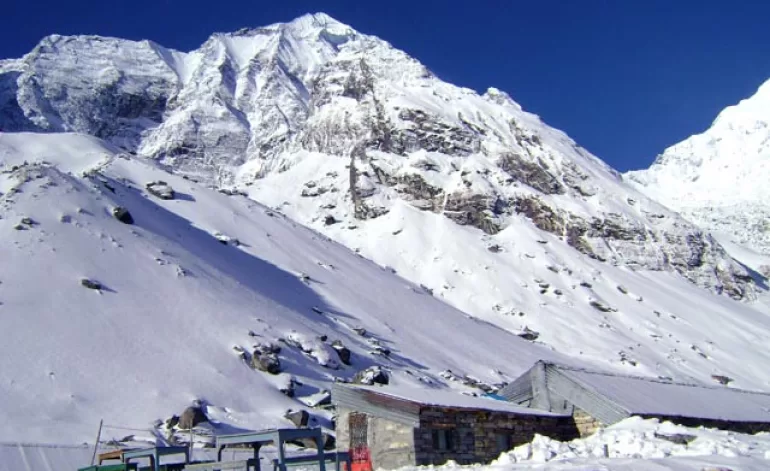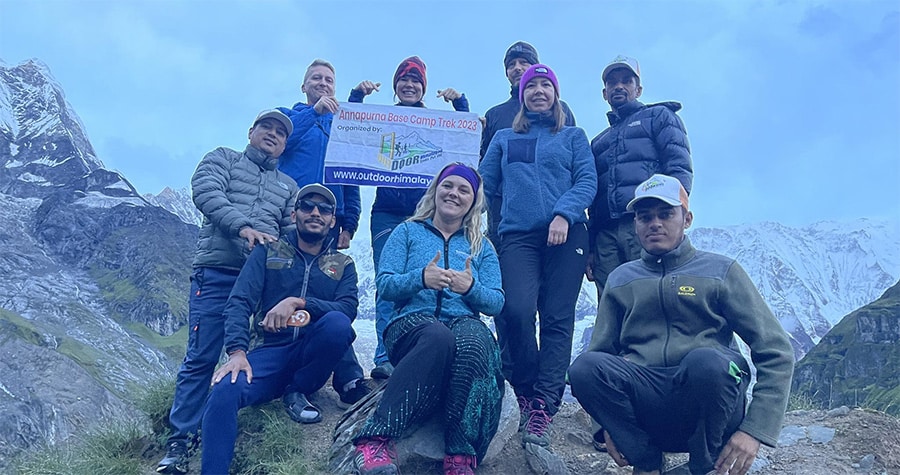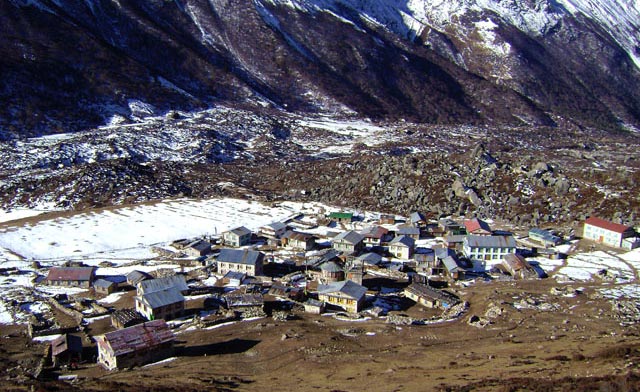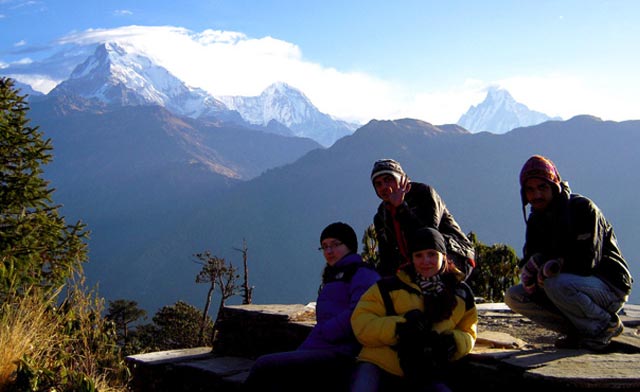
19 Feb 2024 Outdoor Himalayan
Annapurna Base Camp Trek is one of the most popular classic treks in Nepal. In the vicinity of the Annapurna Region, the Annapurna Base Camp trek attracts several travelers annually with its breathtaking scenery, natural greenery, landscapes, snow-covered mountains, rich culture, and uneven trails. Annapurna Base Camp trek is on many travelers’ bucket lists but the question arises on Annapurna Base Camp Trek Difficulty. Is the Annapurna Base Camp trek hard and is it achievable? Yes, the Annapurna Base Camp trek is hard but achievable.
With proper preparations and planning, this moderate trek is possible. To provide detailed insight, we present this article that highlights ‘Annapurna Base Camp Trek Difficulty’ along with some tips to decide you to take and plan for this trek.
Annapurna Base Camp Elevation
Annapurna Base Camp has an elevation of 4,130 m which is also the maximum elevation gain during the trek. But, this trek doesn’t involve any technicality or the use of heavy gear.
Annapurna Base Camp Trek Grade
Annapurna Base Camp trek is graded as a moderate-level trek suitable for trekkers with a medium level of physical fitness. Due to its geographical structure, elevation gain, and daily long walk hours, this trek is preferable for previously experienced trekkers. For beginner trekkers, it is slightly challenging for them. But with good physical fitness, perseverance, and proper preparation beginners can accomplish with smoothly.
Annapurna Base Camp Trek Duration
The standard trek duration is 8 days which starts and ends in Pokhara with 6-8 hours of daily walking. There are mainly 3 routes to Annapurna Base Camp. Thus, the trek route also impacts the trek duration. Travelers can choose the trek route and duration as their preference.

Annapurna Base Camp Trek Difficulty Factors
Trek Route of Annapurna Base Camp
Annapurna Base Camp trek is possible to do through 3 major trekking routes (Ghorepani, Jhinu, and Dhampus). Trekkers can choose their preferred route for the Annapurna Base Camp trek. However, the Ghorepani trek route is difficult compared to Jhinu and Dhampus. But, it allows enough time for beginners to complete the trek as the trek duration is longer.
Trek Duration of Annapurna Base Camp
The standard trek duration of the Annapurna Base Camp is 8 days starting/ending in Pokhara. However, the trek duration varies with the selected trek route. The Ghorepani trek route takes a longer duration as compared to the Jhinu and Dhampus trek routes. It is slightly difficult for trekkers following the Ghorepani route. Jhinu and Dhampus routes have short trek durations but demand walking daily long hours that can be challenging for beginners. The longer the trek duration, the trekkers have the benefit of enjoying the trek as they will have plenty of time to explore at their pace.
Trek Distance of Annapurna Base Camp
Annapurna Base Camp’s trek distance is 80km following the standard itinerary of 8 days. It requires travelers to walk 10 to 20 km each day. For experienced trekkers, it is a piece of cake to complete this Annapurna Base Camp trek. For beginners, it is hard to walk daily 6-8 hours and cross 10 to 20 km distance. They should choose a long-day itinerary to complete their trek without hurry and comfortably. If trekkers wish to complete the trek in shorter days, full planning and preparation are very essential.
Altitude Sickness
Annapurna Base Camp has an elevation of 4,130 m which is also the maximum elevation gain during the trek. It is normal to get altitude sickness above 3,000 m. As trekkers traverse Deurali, they gain elevation and might feel altitude sickness.
Acknowledge the altitude sickness symptoms such as headache, nausea, dizziness, uneasiness, appetite, and sleep loss. Some can experience unconsciousness and hallucinations in extreme cases. Thus, acclimatization rest is essential to prevent altitude sickness.
Besides acclimatization, altitude sickness other preventives are trekking slowly knowing the body limit, eating a balanced diet, avoiding alcohol and salty foods, drinking water and urinating frequently, informing the guide, getting good rest and sleep, and using medicine consulting a guide.
Trekking Trail of the Annapurna Base Camp
Annapurna Base Camp’s trekking trail is one difficult factor for trekkers. The trekking trails during the trek consist of steep stone steps, numerous ascends and descends, rough terrain, and zig-zag trails. Walking on rough trails daily for long hours is demanding for trekkers, especially beginners. Thus, trekkers must have good physical fitness, high stamina, and sound mental fitness to complete this trek. Maintain your pace, don’t push yourself hard, eat a balanced diet, stay hydrated, and be aware of your physical strength.
Weather of Annapurna Base Camp
Weather is another difficult factor for trekkers during the trek. As you trek higher, the weather becomes colder. Annapurna Base Camp has an elevation of 4,130 m, thus weather at the base camp is colder than in the lower regions. It is advisable to trek in the peak seasons for trekkers especially beginners as the weather and temperature are mostly stable and predictable. Expect the day temperature during Spring to be 15-25℃, Autumn to be 15-17℃, Winter to be 5-10℃, and Monsoon/Summer to be 15-20℃.
During the night, the temperature is chilling and cold and falls below 0℃. During Spring, Monsoon, and Autumn, the temperature falls between 5℃ to (-10) ℃. The temperature falls below between 0℃ to (-20)℃ during Winter which makes trekking very difficult as it gets very cold. Thus, we recommend trekking during Spring and Autumn as it offers clear views, good weather, and stable temperatures. Make sure to pack wisely according to seasons for a comfortable trekking experience.
Cost Management
Trekkers find difficulty in proper cost management which makes their Annapurna Base Camp trek expensive. The trek cost varies according to the chosen trek itinerary, trek duration, trek route, transportation, accommodation, additional services, and personal expenses. Manage your budget wisely, discuss with your tour operator beforehand, and arrange accordingly. Prepare a day-to-day budget plan following the itinerary schedule. In higher regions, the costs of goods are higher. In advance, be prepared and we suggest carrying extra cash in case of emergencies. With proper planning, cost management is not difficult for trekkers. Overall good preparation and proper cash management lead to the best and memorable Annapurna Base Camp trekking experience.

Preparation Tips for the Annapurna Base Camp Trek
Before the Trek:
- Participate in exercises and training including cardio to stay physically fit.
- Build strength and stamina by cycling, jogging, and hiking at high altitudes.
- Eat a balanced diet and healthy foods.
- Avoid junk or unhealthy foods, drinking alcohol, smoking, and using unhealthy substances.
- Practice yoga or meditation for mental fitness.
- Make a habit of waking up early and strictly follow your daily routine schedule.
- Do necessary health check-ups before the trek and consult a doctor if necessary.
During the Trek:
- Follow the strict schedule (early wake-up, guidelines, guide’s instructions, eating and drinking habits).
- Maintain a good physical and mental fitness.
- Avoid smoking and drinking alcohol.
- Avoid salty and junk foods during the trek.
- Keep drinking frequently to stay hydrated.
- Take an acclimatization rest to prevent altitude sickness and adjust to the surroundings.
- Use water-purifying solutions to purify drinking water.
- Maintain the trek speed and if any difficulty inform the guide immediately.
- Wear warm but light seasonal clothes and comfortable shoes.
- Make sure to hire a guide and a porter for a safe and memorable trekking experience.
- Stay in the group, follow the main trails, and strictly follow the itinerary schedule.

Additional Info for the Trek
Permits Required
Annapurna Conservation Area Permit (ACAP)
Foreigners- NPR 3000/person
SAARC- NPR 1000/person
Trekkers Information Management System (TIMS)
Foreigners- NPR 2000/person
SAARC- NPR 1000/person
Diplomats/Foreign Officials & their families- NPR 500/person
Packing Essentials
- Clothing (Quick-drying lightweight T-shirts, Long-sleeved shirts, Fleece, Shorts, Down Jacket, Trekking pants, Thermal Inners, Leggings, Inners, Thick socks, Gaiters, Full-finger gloves)
- Beanie, Hat, Scarf, Ear warmers, Cap (seasonal)
- Raincoat, Waterproof jacket
- A light backpack
- Comfortable sturdy shoes, slippers
- Sleeping bag, Camping Tent (Remote regions and High Passes Trek)
- Water bottle and water purification kit
- Prescribed medicines and First-aid kit
- Personal Items (Money, Money Belt, Passport Photograph, Documents, ID, Phone, Camera)
- Personal care kit (Sunscreen, lotion, dust masks, lip balm, face and body wipes, tissues)
Trekking Accessories
- Sunglasses
- Trekking Poles
- Duffle bag or kit bag
- 2-4 Large Plastic bags (to separate clean and dirty clothes)
- 6-10 smaller plastic bags (to dispose of garbage)
- Daypack bag (to carry your requirements)
- Toiletries (Quick drying towel, Toilet paper, Toothbrush, Toothpaste, Soap, Shampoo, Small mirror, Nail cutter)
- Umbrella (optional)
- Headlamp, Torch, Candles, Matches / Lighters, Pocket knife, Whistle
- Binocular, Power Bank, Spare Batteries, Trekking map and compass, Insect Repellant, Sewing Kit, Reading materials, pencil, rubber, pen, and notebook (extras)
Notes
- You can choose to bring this equipment yourself. However, we can help you get these things after you arrive here if you want to travel light.
- We will arrange your pick-up/drop-off according to your flight schedule.
- We can customize the itinerary according to your interests and preferences.
TAGS: Altitude Sickness Annapurna Base Camp Elevation Annapurna Base Camp Trek Difficulty Annapurna Base Camp Trek Difficulty Factors Annapurna Base Camp Trek Duration Annapurna Base Camp Trek Grade Cost Management Preparation Tips for the Annapurna Base Camp Trek Trek Distance of Annapurna Base Camp Trek Duration of Annapurna Base Camp Trek Route of Annapurna Base Camp Weather of Annapurna Base Camp

